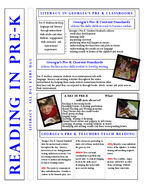Reading in Pre-k Literacy - All day every day
Literacy in Georgia's Pre-K classrooms
Pre-K children develop language and literacy through interactions with adults and other children, engagement with materials, and
instructional experiences.
Georgia's Pre-K Content Standards
address the skills children need to become readers.
Georgia's Pre-K Content Standards address vocabulary development listening skills sequencing of events predicting what will happen in stories understanding the characters and plots in stories understanding the sounds in our language relating sounds to letters of the alphabet and words.
Georgia's Pre-K Content Standards
address the fine motor skills needed to develop writing.
Pre-K teachers immerse students in an environment rich with language, literacy and writing activities throughout the entire instructional day helping them make critical connections between what they hear and the print they are exposed to through books, labels, names and print seen in their environment.
A DAY IN PRE-K
What
will you observe?
Reading & discussing books Retelling Stories & making predictions Shared Reading and Writing Activities Chart Stories and class made books Small group reading Singing Songs Drawing, writing & dictating Flannel board stories and puppets to tell stories Listening, rhyming, counting syllables in words Identifying and naming sounds and their corresponding letters
Georgia's Pre-K teachers teach reading
Georgia's Pre-K Content Standards drive the instructional activities throughout the day. Literacy instruction occurs during planned reading and literacy activities, but also during transition from one activity to another and during play in various learning centers.
LD6c Uses print to communicate ideas and information: Consider a student in the dramatic play area
of the classroom pretending to write a list of items needed from the grocery store.
HPD2b Uses eye-hand coordination to perform fine motor tasks: A student stringing beads in the math area is developing fine motor skills necessary for writing.
LD5g Identifies some individual letters of the alphabet: A student naming and matching magnetic letters
LD6b Uses scribbles, shapes, pictures and letters or other forms of writing: Students creating their own books.
From the experts Pre-k TEACHERs weigh in on reading
We look closely at the text by highlighting certain letters or words, going on word hunts for small high frequency words or use different phonological awareness activities. Some examples of the phonological activities may be listening carefully to the story and looking for all the rhyming words they hear or words that begin with a certain sound. I may ask them to determine the number of syllables by claps, stomps, taps, blinks, etc. in a word or the number of sounds in a word.
Naomi Dycus Cohutta Elementary
I teach reading in many different ways throughout my day in Pre-K. We need to instill a love for books and reading at a young age. Each day in my classroom, I read to the whole group two to three times during the day. During these times, I like to introduce the book by showing the children the cover and talking about what we see on the cover (ex. What do you think this story will be about?), and about the title. We discuss letters in the title and the sounds they make. We also talk about the author and the illustrator.
Christa Dillard, Garden Lakes Primary
A day in our classroom means the chance of a bright future. From the moment the door opens in the morning, they students are greeted with an explosion of language instruction. Every word, song, and book can make a tremendous impact on preparing young children for the first day of kindergarten. As we rhyme each day they are learning the flow of reading; as we sing and dance they are moving and grooving to the literary beat. Each and every conversation that takes place and each page on every book makes real print connections come to life for these children.
Reading in Georgia's Pre-K Classrooms all day every day
Reading in my classroom begins as soon as the first child walks in the room each morning. They read their names to put away their backpacks, find their pictures and sign in on the roll chart. They check the helper chart to see if they have a job and who is doing what job for the day. They read the schedule, words in the school, words on the buses, anything they see! We provide a functionally literate environment that encourages literacy in every aspect. They are learning to read because they are treated as readers. During the morning opening time, we read the name of the month, the days of the week, poems, stories, and songs together.
Teresa Mackey, Rossville Elementary School
When doing art work or writing in their journals, the children dictate to a teacher what their picture is about. It's fascinating to watch their dictations go from a few words here and there to complete thoughts and sentences. After learning to segment words into syllables, we move on to counting the number of words in a sentence. We talk a lot about how `letters' make up words and words make up sentences.
Margaret Rowland, Midway Primary
We focus on listening skills at the beginning of school and then quickly move into rhyming. I use books and songs with rhymes and alliterations in them. We discuss letter sounds and how each letter makes sounds to make up words. We read words by writing letters on the board, making each letter sound, and then putting the sounds together to make a word. I use predictable books, repetitive books for shared reading, and rebus readers. I work with children in small groups and individually.
Jason Coffman, Glenwood Primary
